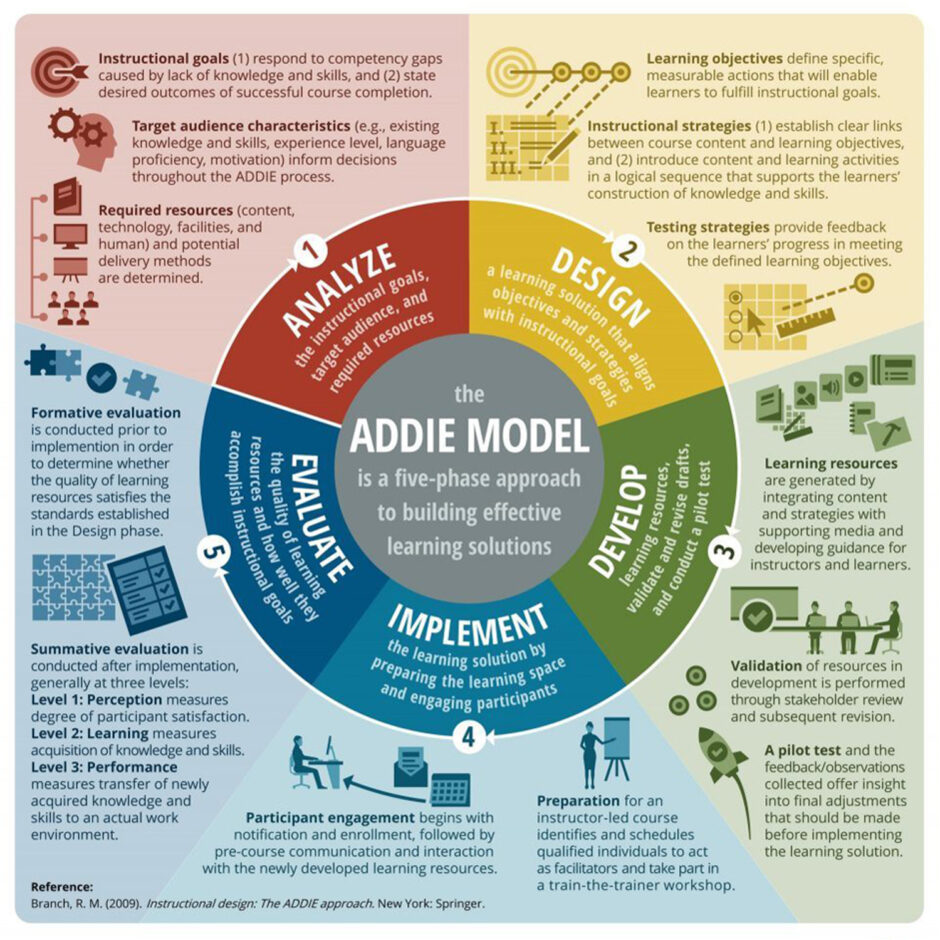Introduction
The ADDIE instructional design framework has long been a cornerstone in education and training, offering a systematic and comprehensive approach to creating an effective learning experience. The acronym stands for Analysis, Design, Development, Implementation, and Evaluation, encapsulating the key stages that guide educators and instructional designers in crafting pedagogically sound and impactful instructional programs.
Analysis: Laying the Foundation
The first phase of ADDIE, Analysis, sets the stage for a well-informed instructional design process. Here, the educational researcher delves into the intricacies of learning needs, goals, audience characteristics, and potential constraints. By conducting a thorough analysis, educators can tailor their approach to address the unique requirements of their learners, ensuring that the instructional program aligns seamlessly with the identified objectives.
This phase’s transferability lies in its adaptability across various educational contexts. Whether designing a curriculum for primary school students or developing a corporate training program, the foundational analysis allows educators to understand the nuances of their audience, creating a more targeted and impactful learning experience.
Design: Crafting a Blueprint for Success
Building upon the insights gained during the analysis, the Design phase involves creating a detailed plan for the learning experience. This blueprint outlines instructional strategies, content, media, and assessments. The transferability of the design phase is evident in its flexibility – it accommodates diverse learning environments and subject matters.
Educational researchers can harness the design phase to tailor their materials to specific learning preferences and styles. Whether employing multimedia elements for visual learners or incorporating interactive modules for hands-on engagement, the design phase ensures that the instructional plan caters to the unique needs of the audience.
Development: Bringing Concepts to Life
The Development phase breathes life into the design by creating or assembling the actual learning materials. From slides and handouts to videos and interactive modules, this phase requires a meticulous approach to align the developed materials with the design specifications. The transferability of the development phase lies in its scalability and adaptability to different technological landscapes.
In the digital age, educators can seamlessly integrate technology into their instructional materials, making learning more dynamic and engaging. The development phase accommodates a spectrum of resources, from traditional classroom materials to cutting-edge eLearning platforms, ensuring that the instructional program remains relevant and accessible across diverse educational settings.
Implementation: Bridging Theory and Practice
With the designed learning materials in hand, the Implementation phase marks the transition from planning to execution. This phase involves delivering the materials to the target audience, whether through traditional classroom settings, virtual platforms, or a combination of both. The transferability of the implementation phase lies in its applicability to various teaching methodologies.
Educators can adapt the implementation phase to suit the needs of different learning environments. Whether facilitating face-to-face interactions or managing virtual classrooms, the principles of ADDIE remain steadfast, providing a versatile framework that bridges the gap between instructional design theory and real-world teaching practices.
Evaluation: Refining for Continuous Improvement
The final phase of ADDIE, Evaluation, assesses the effectiveness of the instructional program. This iterative process involves formative evaluation during development and summative evaluation after implementation. The transferability of the evaluation phase lies in its universal relevance – educators can apply it across diverse educational contexts to refine and enhance their instructional designs continually.
By gathering feedback from learners and stakeholders, educators gain valuable insights into the strengths and weaknesses of their programs. This data-driven approach ensures that the instructional design remains a dynamic and evolving entity, adapting to the changing needs of learners and the educational landscape.
Conclusion
The ADDIE instructional design model stands as a beacon of transferability in education and training. Its systematic and iterative approach allows educators and educational researchers to navigate the complexities of instructional design across various contexts. From the foundational analysis to the continuous refinement through evaluation, ADDIE offers a versatile framework that empowers educators to create meaningful and impactful learning experiences for diverse audiences.
As educational landscapes continue to evolve, the transferability of the ADDIE model remains a testament to its enduring relevance and effectiveness. Educators, armed with the principles of ADDIE, can navigate the ever-changing currents of education, ensuring that their instructional designs stand the test of time and contribute to the growth and development of learners across different settings and demographics.
#InstructionalDesign #ADDIEModel #EduResearch #LearningDesign #AnalysisPhase #EffectiveLearning #DevelopmentStrategies #ImplementationMethods #EvaluationInEd #ContinuousImprovement
Acknowledgements
The ‘ADDIE Model Infographic’ in this article can be found on elearninginfographics.com.




